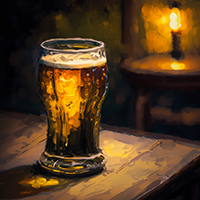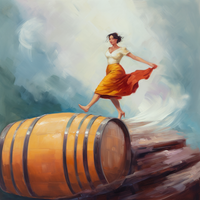The Art of Balance: Alcohol Content and Flavor in Beer and Wine
Posted by Matteo Lahm on 21st Apr 2023
Imagine yourself as a tightrope walker, teetering high above the ground, balancing the fine line between alcohol levels and flavor in your homemade beer or wine. As you craft your libations, it's important to understand the delicate dance between the two and how too much of one overshadows the other. Like a carefully choreographed ballet, achieving the perfect harmony of alcohol and flavor can elevate your homebrew or wine to new, tantalizing heights. Too much alcohol is just falling off the tightrope.

While alcohol content is often seen as an indicator of quality and potency, it is important to recognize that more is not always better. In fact, excessive alcohol can negatively impact the overall flavor profile of your creation if what you are making lacks other elements to properly support it. An Amarone red can go above 16% ABV but, the tannins, oak and heavy fruit forwardness can handle it. A delicate Pinot Noir cannot. Belgian triple and stout beers typically have higher alcohol levels but they are accompanied by lots of hop bitterness. Other characteristics that can be found in these types of beers are a variety of spices, such as coriander, orange peel, pepper, and licorice, as well as fruity esters, chocolate and coffee notes, and a creamy mouthfeel that also provide balance. What is important is to understand what best suits the style of beer or wine you are making.
Aside from deliberate attempts to increase ABV, accidents are also an issue. The balance between the initial sugar content and the yeast's ability to ferment it sets the final alcohol content of your beverage. However, higher alcohol levels can inhibit the yeast's activity, leading to incomplete fermentation and residual sweetness. This excessive sweetness can result in an unbalanced flavor profile that detracts from the overall enjoyment of your creation.
As a maestro conducts an orchestra, alcohol influences the solubility and volatility of various flavor compounds present in beer and wine. While moderate alcohol levels can enhance the perception of certain flavors, an excess can overpower and mask more delicate flavor notes. Additionally, high alcohol content can lead to the extraction of undesirable compounds, such as harsh tannins in wine or excessive bitterness in beer, which can negatively impact the overall flavor profile and sabotage the harmony of your symphony. Higher ABV will naturally increase tannin extraction as alcohol is a solvent.

The sensory perception of alcohol is another important factor to consider when evaluating the relationship between alcohol content and flavor. High alcohol levels can create a burning sensation on the palate and in the throat, which can be very distracting when trying to enjoy nuance. Moreover, excessive alcohol can introduce a "heat" to the flavor profile, overshadowing more subtle flavors and creating an unbalanced drinking experience.
In conclusion, it's essential to strike the right balance between alcohol content and flavor when crafting your beer or wine. While it's tempting to chase the high-alcohol dragon, remember that the art of balance is key. Excessive alcohol can sabotage the overall flavor composition, transforming a potentially enjoyable drinking experience into a letdown, like a bad drunk who ruins the party. Let’s face it, you don’t go through all the trouble to make sophisticated beer and wine just to get drunk. You can do that with cheap vodka. You can always just have another glass of something you enjoy if you want a little more buzz. Alcohol has an important role, but it’s not the only star of the show. By skillfully managing the fermentation process and striking the perfect balance between alcohol content and flavor, you can ensure that your homemade beer or wine is a harmonious delight, worthy of a standing ovation.

